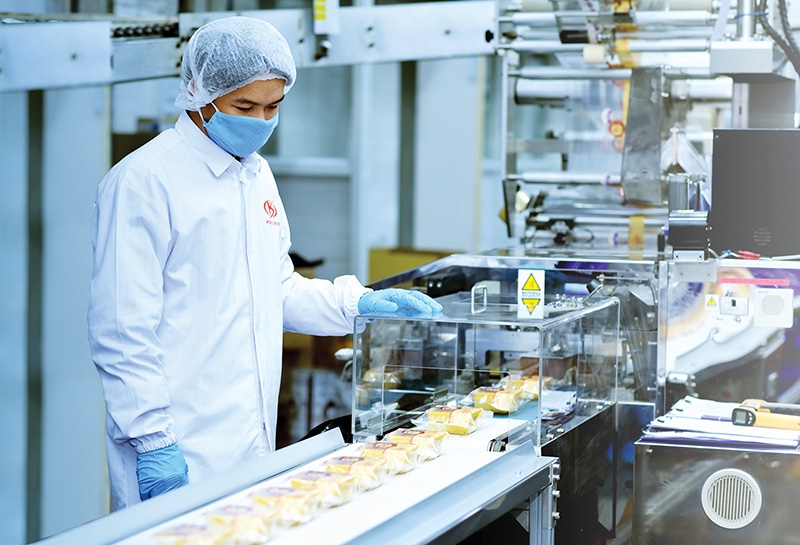Growth indicators to ensure an optimistic scenario
 |
| Processing has been a key driver for strong recovery. Photo: Le Toan |
Deputy Minister of Planning and Investment Tran Quoc Phuong said, “The growth rate of the first quarter at 4.48 per cent was low, from the point of view of the ministry.” However, there is still need for an objective view for this growth, because the 5.2 per cent growth scenario for the first quarter is placed in a state of a “new normal”, but the recent outbreak in the northern province of Hai Duong and some others has pulled economic growth down again down.
“GDP in the following quarters must be increased to reach the National Assembly’s 6.5-per-cent target for 2021,” argued Phuong, who has added that “to outbalance the Q1 growth, in the remaining quarters, there must be a quarter of over 7 per cent.”
Nevertheless, the outcome of the economic growth figures remains unpredictable as COVID-19 could hit again anytime as the latest cases show. Nguyen Thu Oanh, director of the Price Statistics Department under the General Statistics Office, noticed that although the average consumer price index (CPI) in Q1 increased by only 0.29 per cent on-year – the lowest first-quarter increase in the past 20 years – keeping the inflation below 4 per cent this year will not be easy.
Global crude oil prices have been increasing sharply after the United States and other countries in the region launched economic stimulus packages. According to calculations, if the average crude oil price is about $60 per barrel, the CPI in 2021 will increase by 0.9 per cent.
As long as COVID-19 remains a topic, industrial production activities cannot recover as quickly as before, and other sectors like accommodation, catering, transportation, and tourism services are continuing to be affected as well.
However, the economic picture in the first three months also showed many bright spots. Retail sales of consumer goods and services increased by 5.1 per cent in Q1 over the same period last year, showing that consumer demand has increased again. Import-export activities also strongly recovered, and trade balance generated an export surplus of $2.03 billion.
Besides this, the number of newly-registered enterprises in Q1 decreased by 1.4 per cent compared to the same period last year, but the total registered capital increased by 27.5 per cent due to the increase in the number of enterprises with registered capital of over VND100 billion ($4.35 million) and a decrease in those enterprises with than VND10 billion (435,000). These factors will be the impetus for the next quarter to accelerate Vietnam’s economic growth, especially when vaccines are further distributed.
According to Dr. Nguyen Xuan Thanh, a member of the Prime Minister’s Economic Advisory Group, the good news in the first quarter is that all major economies are on their way to recover. Given this optimistic scenario, Thanh sees that while major markets rely on vaccinations to reboot their economies, they also still operate under monetary and fiscal policies towards loosening interest rates, in combination with expanded stimulus packages. In Vietnam, the economy can also follow an optimistic scenario with five basic growth drivers.
First is macro stability, according to Thanh. The expectation of reaching a GDP growth of 6.5 per cent is based on a weak inflationary pressure, so that the government can operate both monetary and fiscal policies in the direction of supporting growth.
Secondly, private investments need to recover, combined with further public investments in infrastructure. Maintaining a low interest rate level and further reducing lending interest rates will be the driving force for businesses’ investments.
Third is the resumption of foreign direct investment (FDI) flows to take place after the pandemic. The trend of supply chain shifts will maintain an attractive position for FDI inflows for Vietnam, but will also create challenges for the monetary and exchange rate regulators to ensure that the country’s economy can still absorb these inputs.
Next involves restoring the purchasing power in the domestic market, Thanh explained. One of the biggest concerns of businesses is that they cannot prosper if the purchasing power of the domestic market remains weak.
The digital transformation has been a huge driver and has led to new types of shopping. Monetary and fiscal policy must also be in a state of supportive growth to restore purchasing power in the domestic market.
Labour market data last year showed that after falling by 2.4 million people in Q2 over the previous quarter, the market recovered with an increase by 1.5 million in the third quarter and 600,000 more in Q4. This is the basis for the recovery of purchasing power in the domestic market this year.
What the stars mean:
★ Poor ★ ★ Promising ★★★ Good ★★★★ Very good ★★★★★ Exceptional
Related Contents
Latest News
More News
- Vietnam GDP posts second-strongest growth since 2011 (January 06, 2026 | 08:35)
- Double-digit GDP growth within reach with shift to higher-value expansion (January 06, 2026 | 08:33)
- Ho Chi Minh City projects $10.5 billion remittance inflows in 2025 (December 31, 2025 | 18:58)
- Digital shift reshaping Vietnam’s real estate brokerages (December 31, 2025 | 18:54)
- New decree sharpens enforcement in securities market (December 31, 2025 | 18:53)
- Voluntary Sustainability Standards pave way for Vietnam’s agricultural exports (December 31, 2025 | 09:00)
- Gold market reform advances as SBV receives applications for bullion production (December 30, 2025 | 12:07)
- Textile apparel firms deliver robust earnings despite global tariff pressures (December 30, 2025 | 10:09)
- Ho Chi Minh City hits $8.37 billion in FDI (December 29, 2025 | 08:28)
- Tax sector wraps up 2025 and sets priorities for next year (December 25, 2025 | 14:00)

 Tag:
Tag:


















 Mobile Version
Mobile Version